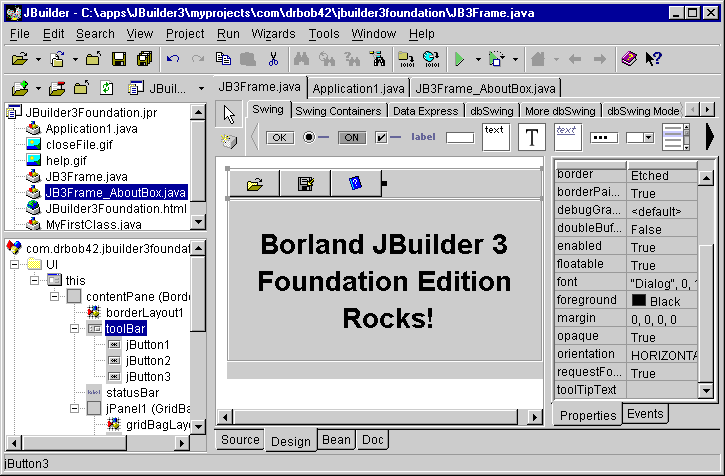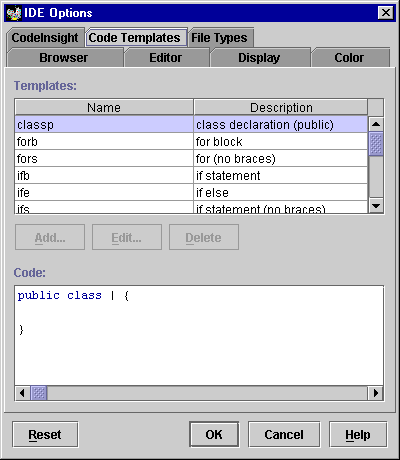Ho, ho, ho!
Christmas comes early this year.
Borland has amazed us Java developers by bringing us Borland JBuilder 3 Foundation Edition:
- A free all Java 2 development environment
- Available for Linux, Unix and Windows NT
- New features!
Borland JBuilder 3 Foundation Edition will be the foundation for the future JBuilder versions.
The Foundation Edition contains basic functionality.
For example Data Express components are supported by the (future) Professional and Enterprise editions, and not in the Foundation Edition.
And when working with the Foundation Edition we encounter disabled buttons and grayed out buttons, which will work in the Professional and Enterprise editions.
We can download the different platform versions from the Borland website.
After downloading the megabytes we can install the Foundation Edition.
Let's look first at the Windows NT version and later we will take a look at the Linux version.
Installing is very easy, we only have to execute the install.exe file and the Foundation Edition will be installed.
The installation also includes JDK1.2.2 and for the new debugging support the Java Platform Debugger Architecture files are included.
And because JBuilder 3 Foundation Edition is completely written in Java 2 we only have to start the right class:
com.borland.jbuilder.JBuilder
Yeah, JBuilder is a Java class!!
The installation program already has created a batch file for setting all the correct classpaths to start JBuilder.
It is time to start JBuilder Foundation Edition:
After JBuilder has loaded we see a very recognizable screen, but with
a few differences. First of all JBuilder has been written in Java 2 with
the JFC Swing classes. So we now see a user interface with the Metal
look and feel, but we can easily change it into a Motif or Windows
look and feel:
 Metal look and feel
Metal look and feel
 Motif look and feel
Motif look and feel
 Windows look and feel
Windows look and feel
If you have ever used JBuilder before you can see a lot of similarities between the old JBuilder and the Foundation Edition, but now it is written in Java.
We still have an AppBrowser window, with the Project browser window at the top left.
A Structure pane window at the bottom left and a larger Content pane window in the middle.
The context of the Content and Structure pane changes accordingly to the type of file we have selected.
With a Java source file we get four tab pages:
Source (the Java source), Design (for visually designing the application),
Bean (for easy creation of JavaBeans), and Doc (for viewing documentation for
the Java file if available). In the next couple of days we will look
at the different contexts with different source files (especially the
HTML context is nice...).
The Foundation Edition contains CodeInsight technology as in the other
JBuilder products. And a couple of little, but useful, changes have been made.
The way we want to view the list of methods and parameters is customizable.
Deprecated methods and members can be shown in a strike-through font
for example.
And besides the already time-saving and error-reducing CodeInsight
technology, we now also can use code templates.
Borland Delphi users already now about code templates, and now we
Java developers can experience the same advantages.
Code templates are predefined pieces of code we can simply insert in our
source code. For example different if, while, and try/catch statements
are implemented:
In our source we only have to type in the name of the code template,
for example
ife
for an if-else statement, and then
press Ctrl-J and JBuilder will automatically create the statement
and we only have to fill in the blanks:
In the Professional and Enterprise editions we
can define our own code templates, for example for creating
documentation with our special style.
JBuilder already had a great editor, and code templates really make it better.
In the next couple of days we will take a closer look at JBuilder 3 Foundation Edition in part 2, part 3 and part 4 of this story.
We will see improved wizards, better help, different panes, syntax highlighting for different files, how to compile, debug, and run applications, on the fly syntax error checking, the Linux version, OpenTools API for extending functionality, and more.
So stay tuned!
BTW, you might think an all Java 2 application must be slow and consumes lots of memory.
I am using a notebook computer with 256MB of internal memory and a Pentium II 300 Mhz processor and JBuilder 3 Foundation Edition runs smoothly and fast.
And it will use only about 35MB of internal memory, which is less than JBuilder 3 Enterprise for Windows!






